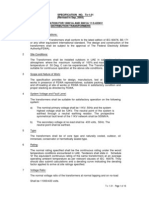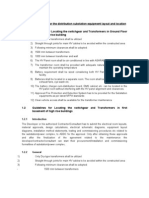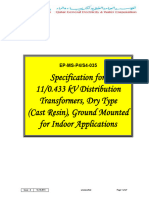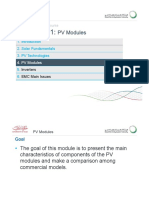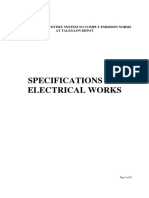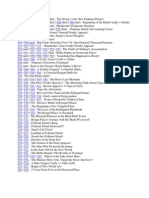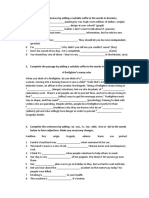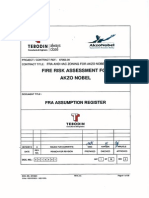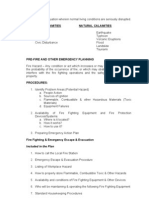Basic Electrical Requirment KSA
Basic Electrical Requirment KSA
Uploaded by
farooq929Copyright:
Available Formats
Basic Electrical Requirment KSA
Basic Electrical Requirment KSA
Uploaded by
farooq929Original Title
Copyright
Available Formats
Share this document
Did you find this document useful?
Is this content inappropriate?
Copyright:
Available Formats
Basic Electrical Requirment KSA
Basic Electrical Requirment KSA
Uploaded by
farooq929Copyright:
Available Formats
SECTION 16010 BASIC ELECTRICAL REQUIREMENTS PART 1 GENERAL 1.01 A. B.
GENERAL REQUIREMENTS All general provisions contained herein or within any other section of the Specifications shall be fully applicable to each and every other section. Works on all the Installation shall be carried out in a neat, efficient and workmanlike manner, assuring satisfactory/proper operation, maintenance and repair. The work shall be in accordance with the requirements of these Specifications, and shall fulfill their true intent and meaning. No deviations from these Specifications and/or Drawings shall be made without written approval of the Engineer. These Specifications and associated drawings form a composite set of documents, intended for the selection and installation of equipment having the general and specific characteristics as detailed. Unless otherwise specifically stated, the installation shall be left complete, tested and ready for operation in all respects and fully integrated and coordinated with all other construction. The Contractor shall submit proof, if requested by the Engineer that the materials, appliances, equipment or devices that he furnishes and installs under this contract, meet the requirements of SASO, NEC and NFPA as regards to fire and casualty hazards. SCOPE OF WORK The work under this division of the Specifications shall include furnishing all labour, materials, equipment and services to install the complete electrical system, putting into operation, tested and commissioned as shown on the Drawings and specified herein. The work includes, but is not limited to, the following principal systems and equipment: 1. 2. Incoming power supply from Electricity Supply Authority.(SEC) Medium Voltage Power Distribution System including MV Switchgear ,RMU, MV Cables, Power Transformers, DC Controls, Battery Charger Unit, protective relays and accessories. Low Voltage Power Distribution System including LV distribution boards, LV cables, panel boards, etc. Emergency Power Generation and Distribution System including standby generator(s), ATS, switchgears and all accessories. Electrical Installations serving all mechanical plants (HVAC & Plumbing) including all LV cabling, trays, disconnect switches and connections to equipment.
C.
D. E.
1.02 A.
3. 4. 5.
BASIC ELECTRICAL REQUIREMENTS 16010 - 1
7.
Electrical Installations serving all special systems and equipment provided under other divisions of the specifications such as elevators, kitchen/laundry equipment, trash compactors, arm barriers, water features, swimming pool, sports equipment and other electric-operated equipment. All kinds of electrical raceways, boxes and fittings. All kinds of wiring devices, dimmers, disconnect switches, starters, electric meters, etc.
8. 9.
10. Interior, exterior, emergency, exit, street, flood, faade and other special lighting. 11. Lightning protection system. 12. Earthing system. 13. All low current systems as detailed in the tender documents. 1.03 A. B. ELECTRICAL SUPPLY The Medium Voltage Electrical Power Supply from SEC primary substation shall be 3 phase, 13.8 kV Delta, 60 Hertz. The Low Voltage Electrical Power Supply and Distribution System shall be 3 phase, 4 wire, 60 Hertz earthed neutral system. The voltage rating shall be 380/220 Volts as shown on the drawings. LIGHTING REQUIREMENTS
1.04
A. Lighting A. Lighting levels will be in accordance with appropriate standards and agreed upon with the Supervising Engineer. Low energy lighting will be the preferred source in all areas. Based on standards set forth by the Illumination Engineering Society (IES), the following maintained illumination levels are recommended : Area Offices Electrical, Telephone and Mechanical Rooms Elevator Equipment Rooms Emergency Egress Control Rooms Store and Cleaning Rooms Cafe Lobbies/Public Areas Toilets Stairways, Corridors and Service Areas Illumination Level (Lux) 500 300 300 20 400 100 300 150 150 150
Lighting points with properly chosen lighting fixtures will be provided with the necessary control devices (local and/or via EIB system which is energy saving system in addition to lighting control system). 1.05 EARTHING REQUIREMENTS A. The earthing system shall in all respects comply with the following : BASIC ELECTRICAL REQUIREMENTS 16010 - 2
1. The National Electrical Code (NEC) NFPA 70. 2. Any special requirements of the Statutory Electricity Supply Authority (SEC). 3. The International Electrotechnical Commission (IEC). 4. Any special requirements of separate earthing for low current systems as per relevant standards or manufacturers recommendations. 5. Any requirements stated within the Specifications. 6. The IEE Wiring Regulations, 16th Edition (1996). B. The earthing system shall take the form of (TN-C) system for the distribution systems and TN-S system in all buildings. The Contractor must ensure that the installation of earthing system complies with the requirements as laid down in section Earthing System contained elsewhere in the Specifications. The earthing conductor (the final conductor by which the connection to the selected means of earthing is made) shall be of copper construction and comply with the requirements of NEC article 250 (NFPA-70). All extraneous conductive parts of any equipment or building installation shall be protected by equipotential bonding in accordance with the requirements of NEC article 250 (NFPA70). LOW CURRENT & SPECIAL SYSTEMS REQUIREMENTS Assign a specialist supplier/designer for all low current and special systems. Specialist suppliers shall verify the design and submit shop drawings and materials based on the requirements of the construction documents and related international standards. The shop drawings and as-built drawings shall be stamped by the suppliers. The suppliers shall support their submittals with catalogues and satisfactory calculations. Bear the cost of any extra item found necessary to have a properly functional system. CO-ORDINATION The contractor shall be solely responsible for the proper co-ordination of all phases of the Work and timely delivery to the site of all equipment and materials for proper execution of the Work. Co-ordinate the Work with all or any other disciplines to ensure proper phasing and continuity of the Works. If it becomes necessary to remake any part of these Works or that of any other discipline or trade as a result of poor or badly timed co-ordination, then all costs associated with remaking those Works will be borne by the Contractor. Co-ordinate with all supply Undertakings and Authorities and shall include for attendance along with all costs involved in re-directing existing services. Take into consideration all statutory and local requirements issued by the Electricity Supply Authority (SEC), Local Authority, Central Government, Broadcasting Authority, Telephone and Telecommunications Authorities along with any other requirements to be considered for the correct and legal operation of the Electrical and Telecommunication Installation or BASIC ELECTRICAL REQUIREMENTS 16010 - 3
C.
D.
1.06 A. B.
C D E 1.07 A
B.
C. D.
equipment connected to the Installation as part of this Contract. Pay all costs due to the requirements of any authority except for connection fees. E. The Contractor shall be responsible for the co-ordination with all Electrical & Mechanical systems suppliers and shall include in his cost all the electrical requirements (even if they were not mentioned in the BOQ or drawings) to have a fully functional system as specified and as recommended by the manufacturer or the codes. This is also applicable to all ancillary systems & equipment such as : Security, Elevators, Escalators, Compactors, Kitchen & Laundry Equipment, Audio-Visual, and all low current systems. CLIMATE CONDITIONS External to building and in non-air conditioned spaces, all apparatus shall be rated for an ambient temperature maximum of 55 oC, minimum of 0 oC, generally dusty desert conditions, a maximum humidity of 100% rh, and an elevation of 100 meters above sea level. In air conditioned buildings, all apparatus shall be rated for ambient temperature of 45 C maximum, minimum of 0 C and a maximum humidity of 90% rh. When equipment is installed in direct sunlight, it shall either be shielded from direct radiation or suitably rated for additional solar gains. Cables shall always be shielded from direct sunlight. All apparatus shall be rated for continuous service twenty four hours a day, seven days a week throughout its normal rated life, except for necessary routine maintenance. All equipment shall be rated for very harsh and corrosive environmental conditions persist at project site. All buried installations shall be suitable for aggressive and salty soil conditions. ACCESSIBILITY All works within the project and particularly above suspended ceilings or inside vertical shafts shall be so installed as to be accessible for operation, maintenance and repair. Deviations from the drawings may be made to accomplish this, but no change shall be made without written approval from the Engineer. Locations of access doors and panels shall be approved by the Engineer before installation work is commenced. STORAGE OF MATERIALS AND EQUIPMENT Comply with Section 01600. All material and equipment, fixed or unfixed, shall be protected against corrosion, deterioration and ingress of foreign matter and moisture. All material and equipment shall be kept clear of the floor or ground by means of wooden bearers and shall be protected against the weather with durable waterproof wrapping and other appropriate means. The Contractor shall be liable for any loss due to delivery, storage or site security problems.
1.08 A.
B.
C.
D. E.
1.09 A.
1.10 A. B. C.
D.
BASIC ELECTRICAL REQUIREMENTS 16010 - 4
1.11 A.
PREVENTION OF NOISE AND VIBRATION Provision shall be made to minimize noise and vibration. However, different manufacturer's equipment will have varying sound and vibration characteristics. The contractor shall be responsible for ensuring that equipment installed does not transmit unnecessary noise or vibration. All equipment installed in plant rooms and outside areas shall not be audible in the occupied areas. Any vibration isolators, isolating bases, flexible connections, silencers, other acoustic treatment or anti-vibration precautions necessary shall be included in the rates for the equipment. In individual cases, the suspension shall ensure that the natural frequency of the vibratory system in the vertical direction is not more than 1/3 of the exciter frequency and never exceeds 25 Hz. Submit proof of the selected noise proofing measures to the Engineer before commencement of work. Submit to the Engineer for information the noise level generation by the plant selected so that structural soundproofing measures can be evaluated. This means either data on the acoustic capacity level in relation to frequency, or the sound pressure level measured at 1 metre from the plant at octave median frequencies from 63 Hz to 4000 Hz. Details of the spatial and operational conditions shall also be given. All costs of noise sound level measurements and any repeat measurements, necessary if acoustic requirements are not met, shall be allowed for by the Contractor. Coordinate and comply with the requirements of noise control as applicable and as given in Section 15513 HVAC Noise Control. GUARDS All moving parts of machinery shall be protected by strong guards to adequately protect all personnel working on or in the vicinity of equipment. The guards shall be constructed in such a manner that the movement of drive belts and rotation of shafts may be readily observed without removal of the guard. All 'live' parts of electrical equipment shall be protected in such a way to adequately protect all personnel working on or in the vicinity of equipment from injury. Wherever possible, all protective guards shall be supplied by the Equipment Manufacturer. All guards shall be strongly attached to equipment and shall be designed to be easily removed for access, servicing, adjustment and maintenance. SIGNS AND NOTICES All signs and notices shall be in Arabic and English with the Arabic version being above or to the right of the English version. A schedule of all signs and notices with proposed Arabic translations shall be approved by the Engineer prior to manufacture.
B C.
D.
E. F.
G. H.
1.12 A.
B. C.
1.13 A. B.
BASIC ELECTRICAL REQUIREMENTS 16010 - 5
1.14 A.
GOVERNING CONDITIONS The entire Electrical Installation shall in all respects comply with the requirements of the latest editions of the following Standards with any current additions and amendments : 1. Saudi Arabian Standards Organization (SASO). 2. Saudi Electric Co. (SEC). 3. Saudi Telecom Co. (STC). 4. National Electrical Code (NEC) NFPA 70. 5. National Fire Protection Association (NFPA). 6. American National Standards Institute (ANSI). 7. National Electrical Manufacturers Association (NEMA). 8. Underwriters Laboratories (UL). 9. Illumination Engineering Society (IES). 10. American Society for Testing and Materials (ASTM). 11. Institute of Electrical and Electronics Engineers (IEEE). 12. International Organization of Standardization (ISO). 13. European Committee for Electrical Standardization (CENELEC). 14. International Telegraph and Telephone Consultive committee (CCITT). 15. International Electrotechnical Commission (IEC). 16. Requirements for Electrical Installations, IEE Wiring Regulation (BS 7671). 17. British Standards (BS). 18. Insulation Power Cable Engineers Association (IPCEA). 19. Requirements or Standards stated elsewhere within the Specifications.
1.15 A.
MOUNTING HEIGHTS Unless otherwise stated on the Drawings, the following shall be mounting heights of equipment above finished floor level subject to full coordination with architectural details and other disciplines/equipment. Any discrepancy found between these heights and other details/disciplines shall be brought to the notice of the Engineer for clarification and final decision. Panel board Isolating switch Light switch Dimmer switch Push button station 1800 mm (Top of panel above FFL) 1350 mm 1350 mm (100 mm from door frame, horizontally) 1350 mm 1350 mm BASIC ELECTRICAL REQUIREMENTS 16010 - 6
Wall mounted telephone/intercom Fire alarm manual call point Fire alarm sounder Fire alarm panel Power outlet Data/Telephone outlet TV/Radio outlet Wall mounted speaker B. C. 1.16 A.
1350 mm 1350 mm 2100 mm 1800 mm (Top of panel above FFL) 300 mm 300 mm 300 mm 2100 mm
Where accessories with varying mounting heights (e.g. light switch and socket outlet) are shown in approximately the same location, their center lines shall be aligned vertically. Where wall mounted accessories are shown adjacent to each other they shall be mounted with their wall plates separated by 50 mm. LABEL AND IDENTIFICATION Each item of the Electrical Installation including electrical switchgear, control gear, equipment, devices, etc. shall be fitted with a non-corrodible label clearly indicating its function giving at least the following information: 1. 2. 3. 4. 5. 6. Manufacturers name. Country of origin. Type / model number or code. Rated voltage, current and frequency (as applicable). Short circuit breaking capacity with time. Compliance mark of the international standard(s).
B.
Prior to final testing, confirm that all labeling is intact over the whole site and that all cables have been fitted with circuit markers. The 13,800 volts cables shall be clearly labeled "DANGER High Voltage" every two meters of their exposed length. All conductors shall have their outer covering coloured to suit the phase to which they are connected.
C.
D.
An instruction notice giving details of first aid treatment for electric shock shall be positioned in an approved position in each switchroom. Manufacturer's or Contractor's names or trademarks shall not be exhibited anywhere through the installation without the prior approval and permission of the Engineer with exception that the Contractor's name and address may be fixed in an approved position on the main incoming switchgear. All labels shall be in English and Arabic. VERMIN PROOFING All items of electrical equipment shall be adequately vermin proofed. Where cables enter or leave the bottoms of switchboards, or pass through pipe ducts, they shall be sealed by the use of hard wood plugs treated with vermin repellent and surrounded by mastic sealant. BASIC ELECTRICAL REQUIREMENTS 16010 - 7
E. 1.17 A. B.
C. D. 1.18 A. 1.19 A.
All spare pipe ducts shall be similarly sealed by the use of solid hard wood plugs. Alternative methods of vermin sealing will be accepted, but the written comments of the Engineer must be obtained prior to installation. FIRE AND SAFETY PRECAUTIONS The whole of the works shall be carried out with care and so arranged as to minimize the risk of fire and the extent of damage resulting from any outbreak of fire. POWER SHUT DOWN PROCEDURES During course of construction there might arise a situation when a power outage or shut down of an existing facility will be required to facilitate power connection of a new installation with the existing facility in operation, or power connection between different phases of a new construction. For such situations or any other situation which require power shut down of an existing facility under operation, submit a work plan for approval to the Engineer, indicating therein the temporary arrangements he shall make to maintain the continuity of power supply to the existing facility. The activities of the work plan shall be scheduled in such a way to give minimum inconvenience to the users or occupants of the existing facility (e.g. shut down during holiday or after working hours) and in proper coordination with all concerned authorities. The work plan shall include, but not limited to the following: 1. 2. 3. 4. 5. 6. 7. 8. List of activities prior to power shut down. List of various authorities to be coordinated prior to power shut down. Sequence of various activities for shut down of power supply. Time duration of each activity. Shut down duration for various activities. Alternate power supply arrangement to maintain continuity of power to the existing facility. Reliability of alternate power supply arrangement. Step-wise sequence of activities for restoration of power supply.
B.
C.
The cost for the provision of activities and other interim arrangements for the continuity of power supply to the existing facility during power shut down procedures shall be deemed to be included in the total price of the tender. PENALTY FOR DAMAGE TO EXISTING UTILITIES Study the location of all the existing utilities and any other facilities, and perform the Work so as not to damage them. In the event that any of such facilities are damaged by the Contractor, the same shall be immediately repaired by the Contractor at his cost and responsibility. In the event that the Contractor damages the existing utilities or facilities listed below, the Contractor shall pay to the Client, in addition to the repair costs, an amount specified below: BASIC ELECTRICAL REQUIREMENTS 16010 - 8
1.20 A.
B.
1. 2. 3. 4.
Power Cable, Control Cable and Instrument Cable Telephone Cable Fresh Water Line Sewer Line
: : : :
An amount equal to one hundred percent (100%) of the actual repair costs. An amount equal to one hundred percent (100%) of the actual repair costs. An amount equal to one hundred percent (100%) of the actual repair costs. An amount equal to one hundred percent (100%) of the actual repair costs.
1.21 A.
SHORT CIRCUIT AND PROTECTION STUDY Obtain the services of the major Electrical Equipment manufacturer to provide a complete computerized study of fault current and coordination of relays, fuses, circuit breakers, and all other protective devices. The Contractor shall coordinate with Electricity Supply Authority (SEC) to include protection settings and fault levels of SEC feeders and circuit breakers in the study. The study shall include all feeders at medium voltage and low voltage system. The Contractor shall obtain all data, characteristic curves and all necessary information from all other trades in connection with his work to provide complete study for the system. The study shall include, but not limited to, the following: 1. 2. 3. 4. 5. Fault current available at each major equipment bus. A tabulation of all protective relay and circuit breaker trip settings and recommended fuse sizes and types. Transformer damage curves in accordance with manufacturer recommendations. Motor starting profile for largest motor in each control center. A complete set of time-current coordination curves on logarithmic scales sheets.
B. C.
D.
E.
The short circuit and protection study shall be bound in a standard A4 size report. The final selection and settings of all protective devices shall be based on this study. The complete study shall be approved by the Engineer. Protective devices shall be adjusted, tested, and calibrated in the field prior to energizing the equipment per the settings listed in the study. SPARES AND CONSUMABLES Provide an unpriced list of spares and consumables to manufacturers recommendation for 1 years operation for every item of plant and system at the time of tendering.
1.22 A.
PART 2 PRODUCTS Not used. BASIC ELECTRICAL REQUIREMENTS 16010 - 9
PART 3 EXECUTION Not used.
END OF SECTION 16010
BASIC ELECTRICAL REQUIREMENTS 16010 - 10
You might also like
- Practical Guides to Testing and Commissioning of Mechanical, Electrical and Plumbing (Mep) InstallationsFrom EverandPractical Guides to Testing and Commissioning of Mechanical, Electrical and Plumbing (Mep) InstallationsRating: 4 out of 5 stars4/5 (4)
- S-AAA-GEN-SQA (Safety & Quality) (Rev.0-2015)Document22 pagesS-AAA-GEN-SQA (Safety & Quality) (Rev.0-2015)Clark HonradoNo ratings yet
- Services Design Checklist For Project PlanningDocument5 pagesServices Design Checklist For Project PlanningIshan RanganathNo ratings yet
- SEWA-E-D-003 33 KV CableDocument37 pagesSEWA-E-D-003 33 KV Cablezaheer2931100% (1)
- Particular Addc SpecsDocument8 pagesParticular Addc SpecsAnonymous kjvaeVJNNo ratings yet
- Electrical Regulations and Standards - Electrical Installation GuideDocument5 pagesElectrical Regulations and Standards - Electrical Installation GuidelgaungNo ratings yet
- Mep SpecificationsDocument274 pagesMep SpecificationsJoe Ps100% (6)
- 5E Homebrew Fleet Combat Rules (Reference)Document2 pages5E Homebrew Fleet Combat Rules (Reference)Colby Savell100% (1)
- Electrical SpecificationsDocument306 pagesElectrical SpecificationsSimple LangNo ratings yet
- Transformers & Ring Main UnitsDocument57 pagesTransformers & Ring Main Unitsoadipphone7031100% (1)
- Substationsfinal2013 PDFDocument137 pagesSubstationsfinal2013 PDFManoj RanaNo ratings yet
- Bare Copper Class 2 Conductor en 13602Document2 pagesBare Copper Class 2 Conductor en 13602madhav287No ratings yet
- The Saudi Arabian Distribution CodeDocument163 pagesThe Saudi Arabian Distribution Codenirmal mohanNo ratings yet
- 11kv Rmu PDFDocument27 pages11kv Rmu PDFSanda KinithiNo ratings yet
- 3.GS03 General Specs For ElectricalDocument25 pages3.GS03 General Specs For ElectricalSHAAM ENG100% (1)
- اشتراطات التعبئة والتغليف تحديث اغسطس 2021Document1,076 pagesاشتراطات التعبئة والتغليف تحديث اغسطس 2021akramNo ratings yet
- Fewa ReqDocument12 pagesFewa ReqMoin AhmedNo ratings yet
- Electical Technical SpecificationsDocument312 pagesElectical Technical Specificationsmohamed DiaaNo ratings yet
- Chapter1. Electrical Installations Standards and RegulationsDocument29 pagesChapter1. Electrical Installations Standards and RegulationsHashem ZohbiNo ratings yet
- Meter Manual Final PDFDocument12 pagesMeter Manual Final PDFAnonymous TAKRGCkb100% (2)
- Guide Lines For The Distribution Substation Equipment Layout and LocationDocument3 pagesGuide Lines For The Distribution Substation Equipment Layout and LocationAnirban Chakraborty67% (3)
- CV For MEP Site EngineerDocument3 pagesCV For MEP Site EngineerMohamed IbrahimNo ratings yet
- S MVS Temp Pu - 00Document51 pagesS MVS Temp Pu - 00afsar.erNo ratings yet
- MCCB Specs PDFDocument6 pagesMCCB Specs PDFAbdElrahman AhmedNo ratings yet
- FEWA LV Cable SpecsDocument46 pagesFEWA LV Cable Specsjtwani100% (2)
- Fewa SpecificationsDocument28 pagesFewa SpecificationsAnonymous GdZqtY88ZRNo ratings yet
- Good Sample: (Workmanship - Baseplate Anchor Bolt Support & Grouting)Document36 pagesGood Sample: (Workmanship - Baseplate Anchor Bolt Support & Grouting)Kamran AkhtarNo ratings yet
- ADDC - Musaffah Region Sector M-33Document89 pagesADDC - Musaffah Region Sector M-33Afsal JhNo ratings yet
- Selecting An Automatic Capacitor Size 480V System To ADocument5 pagesSelecting An Automatic Capacitor Size 480V System To Arafe788No ratings yet
- S Aa Cps MV LV Prot (Rev 0 2015)Document46 pagesS Aa Cps MV LV Prot (Rev 0 2015)nknfiveNo ratings yet
- UAE Earthing Appendices Electricity Wiring Regulations 5-8-200703 51 179552500Document40 pagesUAE Earthing Appendices Electricity Wiring Regulations 5-8-200703 51 179552500KT MENON100% (1)
- 05 SWGR & ProtectionDocument45 pages05 SWGR & ProtectionMohamed GaniNo ratings yet
- Kahramaa Transformer Specifications 2011Document27 pagesKahramaa Transformer Specifications 2011Isa Ronrro100% (1)
- EP-DP-C1 Electricity Planning Regulations For Supply-FinalDocument27 pagesEP-DP-C1 Electricity Planning Regulations For Supply-FinalVladimir Simeunovic100% (2)
- S MVS DSTR - 00Document45 pagesS MVS DSTR - 00afsar.erNo ratings yet
- SF6 SwitchgearDocument7 pagesSF6 SwitchgearkarimakkiNo ratings yet
- 51 Sdms 01rev022 For Distribution TransformerDocument20 pages51 Sdms 01rev022 For Distribution Transformernadeem UddinNo ratings yet
- Muhsin Hussain - Electrical Project EngineerDocument2 pagesMuhsin Hussain - Electrical Project EngineerAshiqRahimanNo ratings yet
- Specification For Electrical Installations: Rev. Date Description/issued For Prepared Authorised Client: Project: TitleDocument55 pagesSpecification For Electrical Installations: Rev. Date Description/issued For Prepared Authorised Client: Project: TitleNael SwedanNo ratings yet
- Summer Training at SeccoDocument13 pagesSummer Training at SeccoHassan SaeedNo ratings yet
- Street Lighting Technology ComparisonDocument7 pagesStreet Lighting Technology ComparisonManoj KavediaNo ratings yet
- Addendum 5 - Part I - Instructions To Bidders - RedlineDocument96 pagesAddendum 5 - Part I - Instructions To Bidders - RedlinenazihsedrakNo ratings yet
- L-S14 11kV SF6 Ring Main Unit (RMU)Document36 pagesL-S14 11kV SF6 Ring Main Unit (RMU)Yoko Zhan SNINo ratings yet
- Technical Data 11kV AIS VHIHDocument6 pagesTechnical Data 11kV AIS VHIHSelvin Francis100% (2)
- Aboalazaim Maghraby ELectrical Engineer 15-8Document2 pagesAboalazaim Maghraby ELectrical Engineer 15-8Maddy El MaghrabyNo ratings yet
- ADDC ProcessDocument19 pagesADDC ProcessfaizalpsNo ratings yet
- EP-MS-P4-S3-075 - 11kV Heat Shrinkable Cable Terminations - KM Material..Document14 pagesEP-MS-P4-S3-075 - 11kV Heat Shrinkable Cable Terminations - KM Material..dimaomarNo ratings yet
- HCIS-lighting Standard 2017 V 2Document18 pagesHCIS-lighting Standard 2017 V 2Ahmad KhameesNo ratings yet
- S-AAA-CAB-LV-MC-S&I (Rev.0-2015)Document7 pagesS-AAA-CAB-LV-MC-S&I (Rev.0-2015)FlavioNo ratings yet
- 1 4 & 1 5 DEWA Training - PV Modules R1Document59 pages1 4 & 1 5 DEWA Training - PV Modules R1jayapalNo ratings yet
- 11.specifications For Electrical WorksDocument36 pages11.specifications For Electrical WorksBalamurugan ArumugamNo ratings yet
- S-AAA-CAB-ACC-LV-S&I (Rev.0-2019)Document10 pagesS-AAA-CAB-ACC-LV-S&I (Rev.0-2019)Wael AlmassriNo ratings yet
- Load ScheduleDocument18 pagesLoad SchedulevijayNo ratings yet
- MDB Specs PDFDocument9 pagesMDB Specs PDFAbdElrahman AhmedNo ratings yet
- Section 16010Document10 pagesSection 16010وسام اللبديNo ratings yet
- Ee SpecificationsDocument129 pagesEe SpecificationsDavid GarrettNo ratings yet
- Section 26 05 00-Common Work Results For Electrical PDFDocument9 pagesSection 26 05 00-Common Work Results For Electrical PDFmasoodaeNo ratings yet
- SpecificationsDocument7 pagesSpecificationsvenkat0236No ratings yet
- Technical Specification of IeDocument18 pagesTechnical Specification of IeBhanu PratapNo ratings yet
- Ee Tech Specs 2022Document37 pagesEe Tech Specs 2022Eric LopezNo ratings yet
- Tproc Noticesnotices 035 Knotice Doc 31583 582102243Document156 pagesTproc Noticesnotices 035 Knotice Doc 31583 582102243Anthony Robert XNo ratings yet
- 2023Summit-Priotitizing Water Efficiency-SlidesDocument46 pages2023Summit-Priotitizing Water Efficiency-Slidesfarooq929No ratings yet
- NZM Catalog 02 2012 enDocument234 pagesNZM Catalog 02 2012 enengenhariamaccari100% (2)
- Britool TORQUE WRENCH PDFDocument2 pagesBritool TORQUE WRENCH PDFfarooq929100% (1)
- TM Smartcool 6 200kwDocument194 pagesTM Smartcool 6 200kwfarooq929No ratings yet
- IP AddressesDocument23 pagesIP Addressesfarooq929No ratings yet
- ISO13 CHK DemoDocument5 pagesISO13 CHK Demofarooq929No ratings yet
- Legrand SwiftclipDocument4 pagesLegrand Swiftclipfarooq929No ratings yet
- Cablofil Steel Wire Cable TrayDocument132 pagesCablofil Steel Wire Cable Trayfarooq929No ratings yet
- Guide To Low Voltage Circuit Breaker StandardsDocument21 pagesGuide To Low Voltage Circuit Breaker StandardsAnonymous BBX2E87aHNo ratings yet
- Eton MCCB PDFDocument64 pagesEton MCCB PDFfarooq929No ratings yet
- Power CablesDocument33 pagesPower Cablesfarooq929No ratings yet
- One Piece EpisodeDocument13 pagesOne Piece EpisodeRahmad Syafrizal GintingNo ratings yet
- Adjective Suffixes 2Document2 pagesAdjective Suffixes 2vericliNo ratings yet
- Polypropylene (Homopolymer)Document4 pagesPolypropylene (Homopolymer)Fadilla Soraya IsfahaniNo ratings yet
- Sas12 Shotgun ExplodedDocument8 pagesSas12 Shotgun Explodedsjdarkman1930No ratings yet
- First Look: A Spark UnseenDocument30 pagesFirst Look: A Spark UnseenI Read YANo ratings yet
- Mock Drill Oil Bottling Plant - BangaloreDocument34 pagesMock Drill Oil Bottling Plant - Bangaloresaquib_jamadarNo ratings yet
- Fire Protection of BuildingsDocument141 pagesFire Protection of BuildingsWashington Anjichi Okang'a100% (3)
- Badger Class K Datasheet enDocument2 pagesBadger Class K Datasheet enaamedNo ratings yet
- Operation and Process: Starting A BoilerDocument3 pagesOperation and Process: Starting A BoilerJoanna MarieNo ratings yet
- NSDC - ADVANCE CERTIFICATE IN INDUSTRIAL FIRE AND SAFETY MANAGEMENT SyllabusDocument23 pagesNSDC - ADVANCE CERTIFICATE IN INDUSTRIAL FIRE AND SAFETY MANAGEMENT Syllabusbasant26No ratings yet
- Material Safety Data Sheet: Alcohol 70%Document7 pagesMaterial Safety Data Sheet: Alcohol 70%Nadia CristineNo ratings yet
- 2 JHA On Shot Grit Blasting1Document3 pages2 JHA On Shot Grit Blasting1Akhilesh KumarNo ratings yet
- RAB Fire AlarmDocument5 pagesRAB Fire AlarmAlex Sandro Oktavian100% (1)
- FRA Assumption RegisterDocument30 pagesFRA Assumption Registeradrianstyd100% (1)
- Safety and Emergency RemindersDocument11 pagesSafety and Emergency RemindersYssa ManilaNo ratings yet
- MadRiverUnion 07 05 17Document16 pagesMadRiverUnion 07 05 17Mad River UnionNo ratings yet
- Nib Polypropylene Plastic Fittings Valves MsdsDocument5 pagesNib Polypropylene Plastic Fittings Valves MsdsMorris MorrisonNo ratings yet
- Epoxy CoatingDocument8 pagesEpoxy CoatingBike To Work100% (1)
- Example Fire and Emergency Evacuation PlanDocument6 pagesExample Fire and Emergency Evacuation PlanMateo RosasNo ratings yet
- Method Statement-Ext Pipe FittingsDocument13 pagesMethod Statement-Ext Pipe FittingsSam JoseNo ratings yet
- MSDS - Natural Gas CondensatesDocument7 pagesMSDS - Natural Gas CondensatesChad HornNo ratings yet
- MC MarksmanshipDocument124 pagesMC MarksmanshipJared RinehartNo ratings yet
- Construction Safety CodesDocument3 pagesConstruction Safety CodesDeddy SetiawanNo ratings yet
- DISASTER - A Situation Wherein Normal Living Conditions Are Seriously Disrupted. Man Made Calamities Natural CalamitiesDocument13 pagesDISASTER - A Situation Wherein Normal Living Conditions Are Seriously Disrupted. Man Made Calamities Natural CalamitiesJella BandalanNo ratings yet
- 7 in 1 SmokerDocument12 pages7 in 1 SmokerNick CulianosNo ratings yet
- 2017 British Columbia Fires: One Year Donor UpdateDocument12 pages2017 British Columbia Fires: One Year Donor UpdateAnonymous xWYSmSNo ratings yet
- Firerescue201609 DLDocument80 pagesFirerescue201609 DLDitmar LafitteNo ratings yet
- EHS Activity CalendarDocument3 pagesEHS Activity Calendarm.rajkumarNo ratings yet
- INTA212 Week6 Assignment1 King CDocument85 pagesINTA212 Week6 Assignment1 King CCharvidaNo ratings yet









